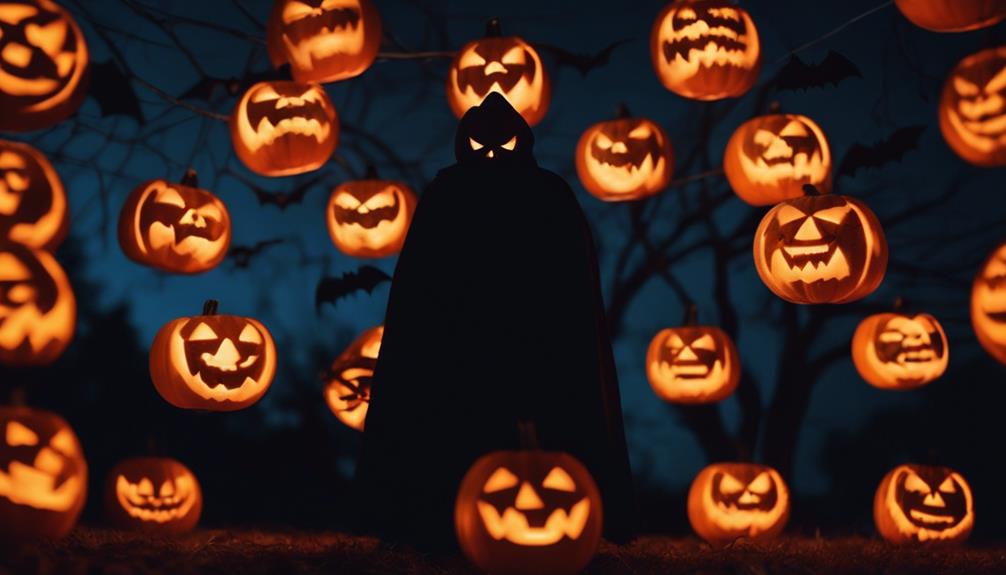Many classic monsters come from real fears and historical events. Vampires trace back to medieval rituals and stories of corpses returning from the dead. Werewolves stem from superstitions about shape-shifting and accusations of lycanthropy. Ghosts are linked to cultural beliefs, hauntings, and tragic accidents. Zombies originate from real illnesses like rabies and supernatural rituals. Exploring these origins reveals how ancient fears and legends shape the spooky stories we still believe today. Keep going to uncover more secrets behind these legends.
Key Takeaways
- Many classic monsters like vampires and werewolves originate from medieval folklore, symbols of societal fears, and superstitions about death and transformation.
- Stories of ghosts and hauntings are rooted in cultural beliefs, historical events, and rituals that interpret supernatural encounters as warnings or spirits.
- Mythical creatures such as cryptids reflect cultural anxieties, often blending folklore with historical incidents to explain mysterious phenomena.
- Notorious figures like Jack the Ripper and Vlad the Impaler inspired legends that merge fact with fiction, shaping modern horror archetypes.
- Media sensationalism and folklore have perpetuated myths of curses, reanimated corpses, and supernatural entities, blending history with cultural imagination.
The Origins of Vampires in Folklore and History

Vampires have long haunted human imagination, but their origins lie deep in folklore and history. In medieval times, rituals were performed to protect communities from evil spirits, often involving symbols that later influenced vampire lore. These practices sometimes included grave desecration or the belief that corpses could return as blood-drinking monsters. Over centuries, vampire literature emerged, shaping modern perceptions of these creatures. Early stories depicted vampires as revenants, or returning dead, fueling fears and superstitions. Such tales reinforced the idea that vampires could be created through curses or improper burial rites. These historical and folkloric roots laid the foundation for the enduring myth, transforming local legends into the vampire archetype we recognize today in popular culture. Additionally, the role of attention in these stories helped reinforce the fears and superstitions surrounding vampires, emphasizing the importance of cultural focus in shaping folklore.
Werewolves: From Shifts in Belief to Real-Life Cases
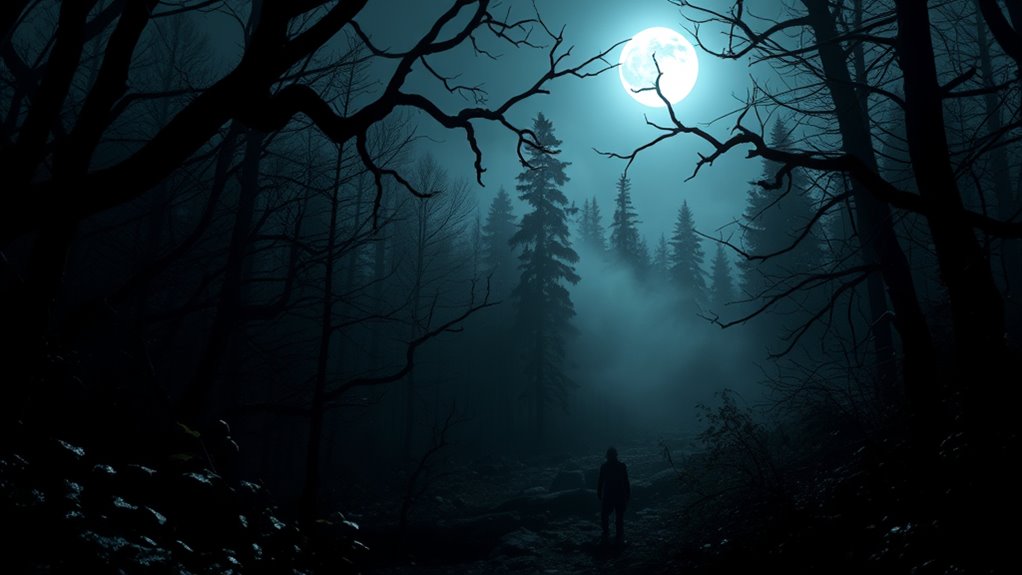
Throughout history, folklore and mythology have shaped our understanding of werewolves as shape-shifting creatures. You’ll also encounter cases where supposed real-life incidents fueled fears and beliefs in these creatures. These stories blur the line between legend and reality, making the history of werewolves all the more fascinating. For instance, certain vetted products and practices may have inadvertently contributed to these myths by influencing perceptions of appearance and behavior.
Folklore and Mythology
Werewolves have long fascinated humanity, evolving from ancient folklore into stories that blur the line between myth and reality. Their mythical origins trace back to legends across cultures, where they symbolize human fears and the unknown. Over time, these stories fueled cryptid sightings, with people claiming to see wolf-like creatures or shapeshifters lurking at night. In folklore, werewolves represent both literal monsters and metaphorical ideas of transformation and loss of control. These tales helped shape cultural beliefs and fears, often serving as cautionary stories or explanations for mysterious crimes. By understanding the mythology behind them, you see how deeply rooted these creatures are in human imagination, blending cultural symbolism with the enduring allure of the supernatural. Additionally, projector technology has played a role in bringing vivid, realistic images to life, much like how stories of monsters have been visually depicted in films and media.
Notable Historical Cases
The shift from myth to reality becomes evident when examining historical cases where accusations of lycanthropy led to trials and executions. During medieval executions, individuals accused of being werewolves faced brutal punishments rooted in fear and superstition. Many believed these accusations stemmed from ancient curses or malevolent spirits, fueling hysteria. In some regions, people were condemned based on mere suspicion, often after confessing under torture. These cases reveal how societal fears transformed into deadly actions, blurring the line between myth and perceived truth. The belief in werewolf transformations persisted through centuries, fueling witch hunts and harsh punishments. Modern understanding of superstitions and ignorance demonstrates how false beliefs can result in tragic, often fatal, outcomes. Today, these historical cases serve as chilling reminders of how superstition and ignorance once led to tragic, often fatal, outcomes.
Ghosts and Spirit Sightings: Cultural Roots and Historical Events

You might notice that cultural beliefs shape how people perceive and report ghost sightings, often reflecting their traditions and fears. Notable historical hauntings, like the Tower of London or the White House, reveal how these stories endure over time. Modern encounters continue to be influenced by folklore, blending ancient legends with today’s ghostly experiences. Additionally, the continuity of these stories is supported by cultural trends, which help preserve and transmit ghostly tales across generations.
Cultural Beliefs Influencing Sightings
Cultural beliefs deeply shape how people perceive and interpret sightings of ghosts and spirits. These perceptions are often influenced by supernatural symbolism and myths passed through generations. For example, certain symbols or stories can frame spirits as vengeful or protective, depending on cultural context. Mythical origins often underpin local legends, giving supernatural encounters a familiar meaning. Your understanding of these sightings is colored by cultural narratives, shaping whether you see them as warnings, ancestors, or lost souls. Recognizing this helps you see how societal beliefs guide interpretations. Additionally, popular supernatural themes often emerge from these cultural influences, further reinforcing collective perceptions.
Notable Historical Hauntings
Many of the most famous hauntings are rooted in specific historical events that have left a lasting supernatural imprint. You’ll find many spirits linked to medieval festivals, where chaos and emotion heightened the belief in spirits lingering after death. Ancient rituals, performed to appease or summon spirits, often created environments ripe for hauntings. These events blurred the line between the living and the dead, leaving behind echoes of fear and sorrow. For instance, ghost sightings during historic celebrations often coincide with times when communities engaged in rituals meant to honor or ward off spirits. Over time, these moments became embedded in local lore, turning into stories of ghostly apparitions that still haunt the sites of these ancient festivals and rituals today. Cultural roots of these hauntings often reveal the deep connections between community traditions and supernatural beliefs.
Folklore and Modern Encounters
Ghost sightings and spirit encounters often stem from deep-rooted folklore that has been passed down through generations. These stories shape how cultures perceive supernatural legends and influence modern encounters. Many claim to witness cryptid sightings, which fuel beliefs in mysterious creatures lurking nearby. These sightings often tie back to local legends, reinforcing the idea that certain places are haunted or cursed. Cultural narratives help explain eerie experiences, giving context to unexplained phenomena. Whether it’s a ghostly apparition or a strange creature in the woods, these stories create a shared sense of wonder and fear. Additionally, batteries and energy storage technology plays a role in how modern societies prepare for and respond to mysterious phenomena, illustrating the link between technology and cultural storytelling.
- They preserve cultural identity through stories of the supernatural
- Cryptid sightings often originate from folklore passed down for centuries
- Legends evolve, blending history with imagination
- Such encounters keep supernatural legends alive today
The Tale of the Jack the Ripper: Myth and Mystery
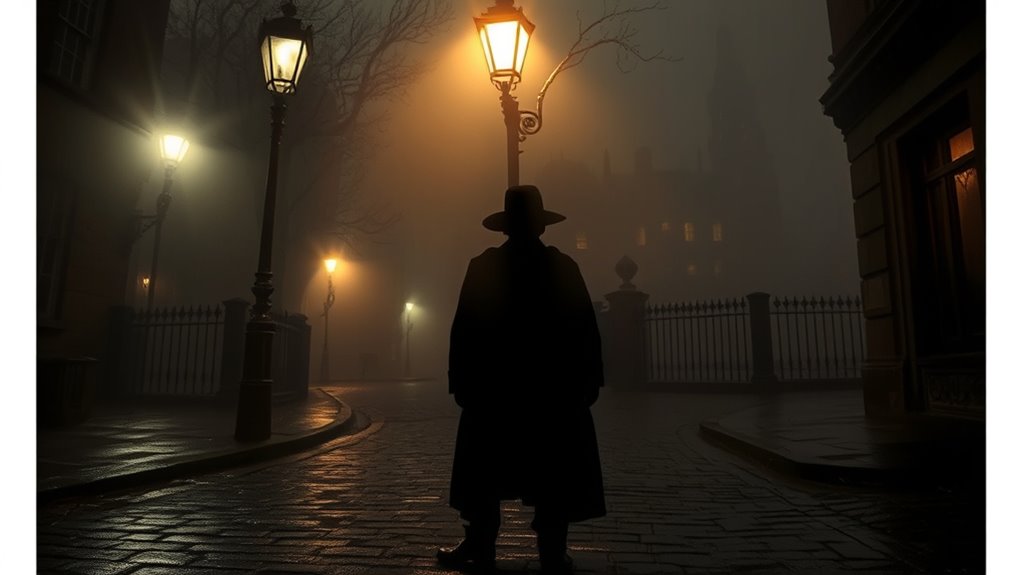
The story of Jack the Ripper continues to captivate and terrify because it blurs the line between fact and fiction. You’re drawn into urban legends that mix myth vs reality, fueling speculation for over a century. His identity remains unknown, fueling countless theories and false leads. The mystery blends real crime scenes with mythic elements, creating a haunting legend. To understand the myth, consider this table:
| Aspect | Fact | Myth |
|---|---|---|
| Victims | Real women murdered in 1888 | Some stories suggest supernatural powers |
| Killer’s Identity | Unsolved, remains unknown | Many claim to have identified him |
| Public Response | Media frenzy, public fear | Stories exaggerated, adding to myth |
| Impact | Influenced horror stories and urban legends | Created an enduring myth of terror |
This mix of myth vs reality keeps Jack the Ripper alive in our collective imagination. Additionally, the unsolved nature of the case has contributed to its enduring mystique, allowing myths to flourish alongside the known facts.
The Legend of Dracula and Vlad the Impaler
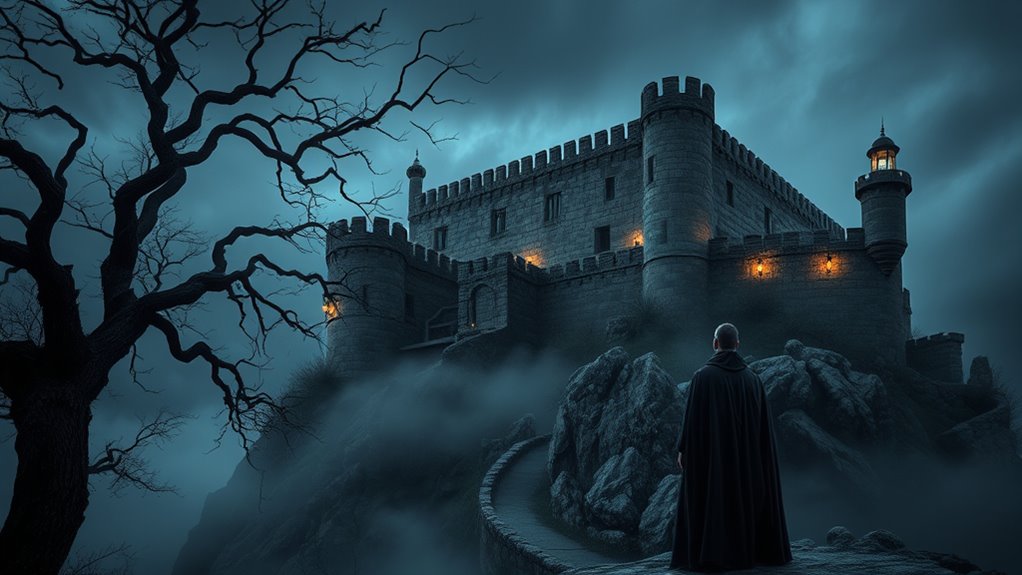
Vlad the Impaler’s brutal reign inspired legends of cruelty and fear that blend history with folklore. His origins and ruthless tactics shape the dark myth of Dracula, a figure shrouded in mystery. As you explore, you’ll see how historical facts and myths intertwine to create this chilling legend. The influence of father figures and their role in shaping perceptions of strength and fear are also reflected in the stories surrounding Dracula.
Vlad’s Brutal Reign
Amidst the dark history of Eastern Europe, a ruthless ruler’s brutal tactics left a chilling legacy that would inspire legends for centuries. Vlad the Impaler’s reign was marked by extreme cruelty, using methods like medieval torture to instill fear. His reputation for impaling enemies spread rapidly, fueling stories that blurred the line between fact and myth. These acts influenced vampire legends, as locals whispered about a bloodthirsty monster lurking behind his ferocity. His brutal methods weren’t just for punishment—they served as psychological warfare, ensuring obedience through terror. The legend of Dracula emerged from this dark era, blending Vlad’s real atrocities with supernatural fears. His reign’s brutality continues to haunt history, shaping the terrifying image of a vampire lurking in the shadows. Recognizing the historical context behind these stories helps us understand how legends can be rooted in real atrocities.
Origins of Dracula
The brutal methods used by Vlad the Impaler in his reign laid a dark foundation for a legend that would transcend history. His gruesome acts fueled vampire symbolism, which would evolve into the myth of Dracula. As folklore spread, this dark figure merged with stories of blood-drinking monsters, blending fact with fiction. Over time, the legend morphed, reflecting societal fears and superstitions. Understanding this evolution helps you see how Vlad’s reputation influenced the Dracula myth. The following table summarizes this process:
| Vlad the Impaler | Folklore Evolution | Dracula Legend |
|---|---|---|
| Ruthless ruler | Mythical blending | Cultural icon |
| Impalement used | Vampire symbolism | Horror archetype |
| Historical figure | Supernatural stories | Literary creation |
Additionally, the zoning regulations in various regions impacted the way these legends were integrated into local culture and stories.
Historical Myths and Folklore
Many legends surrounding Dracula and Vlad the Impaler have roots that blur the line between history and folklore. These stories often blend real events with supernatural phenomena, fueling myths that persist today. You might encounter tales of cryptid sightings linked to the vampire myth, or stories of supernatural phenomena that heighten the sense of fear and mystery. The dark reputation of Vlad’s cruelty fuels supernatural folklore. Tales of cryptid sightings connect to vampire legends. Folklore often exaggerates Vlad’s brutality into supernatural evil. Supernatural phenomena, like unexplained shadows, reinforce the myth. Additionally, the metabolic changes associated with low carb diets have been compared to the transformation of myths into enduring legends, illustrating how stories evolve over time. These myths reflect a mixture of historical fact and legendary storytelling, creating a haunting image that endures in popular culture and keeps the legend alive.
Chupacabra: The Beast of Latin American Lore

When reports of a mysterious creature began surfacing across Latin America, locals quickly dubbed it the Chupacabra, or “goat-sucker,” due to its reported habit of draining livestock’s blood. These cryptid sightings date back to the 1990s, with farmers describing a creature that leaves behind mutilated animals. Its folklore origins are rooted in indigenous stories and urban legends, blending fears of unknown predators with local cultural beliefs. Some describe the Chupacabra as a reptilian creature with spines along its back, while others see it as a hairless dog-like figure. Despite the lack of concrete evidence, these stories persist, fueling myths and suspicion. The creature’s reputation continues to grow, intertwining folklore with modern cryptid sightings across Latin America. Exploring the supernatural origins of these legends reveals how cultural beliefs shape cryptid narratives.
The Wendigo: a Monster Born From Fear and Hunger

Stories of mysterious creatures often stem from deep-seated fears and cultural anxieties, and the Wendigo is no exception. This legendary monster embodies themes of insatiable hunger, greed, and isolation, making it a powerful cultural symbolism. Over time, its myth has evolved, reflecting societal fears of starvation and moral decay. The myth of the Wendigo has also been influenced by cultural symbolism, illustrating how storytelling serves as a means to process collective emotions and societal issues. You should recognize that the Wendigo’s myth evolution highlights how communities process collective anxieties through storytelling. Its frightening image warns against greed and moral corruption, symbolizing the destructive consequences of selfishness.
The Black Dog Mysteries and Superstitions
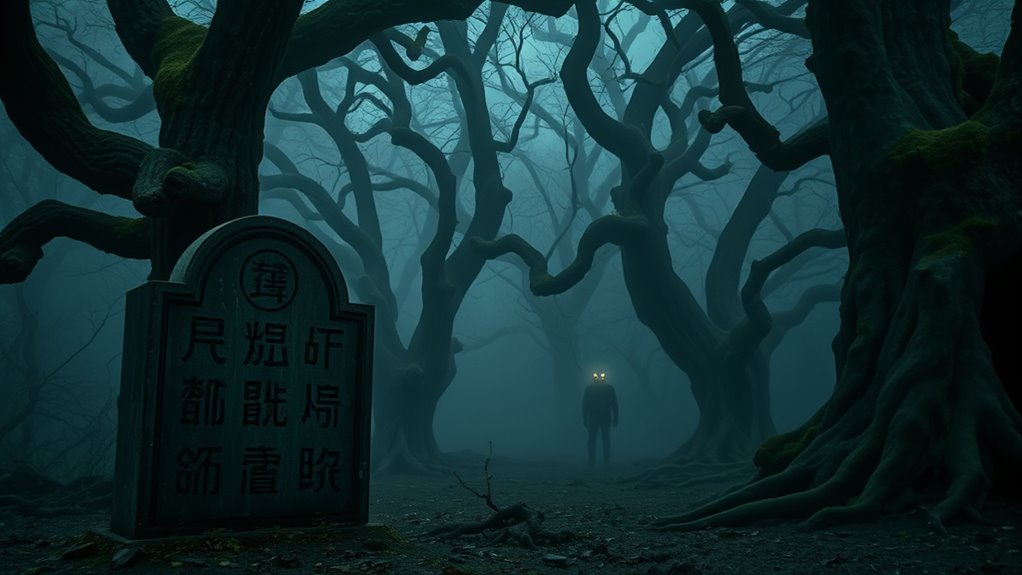
Have you ever encountered a black dog lurking in the shadows and wondered about its mysterious presence? These dog sightings have fueled superstitions for centuries, often seen as omens of death or disaster. Historically, black dogs appeared at night or near graveyards, reinforcing fears rooted in superstition origins. Many believed these creatures were spectral or supernatural, linked to death spirits or ghosts. In some regions, they were called “Hounds of Hell,” warning of imminent tragedy. Their eerie appearances sparked tales that black dogs could appear without warning, acting as messengers from the Otherworld. Today, these sightings still evoke a sense of mystery, but they also reveal how ancient superstitions shaped perceptions of these mysterious, shadowy figures that continue to haunt folklore. The superstitions surrounding black dogs have persisted, influencing cultural stories and fears across generations.
The History Behind the Mummy’s Curse
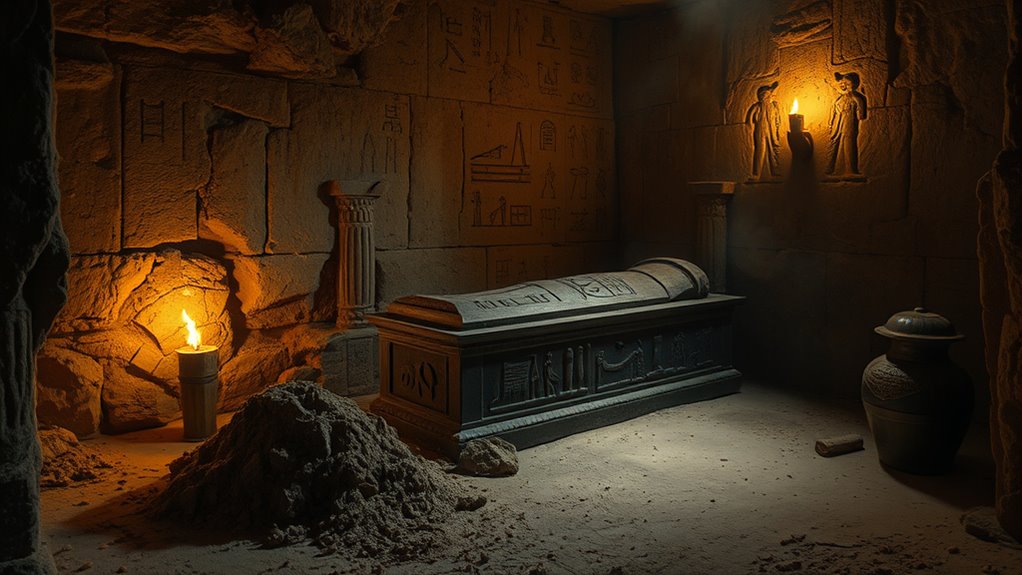
The idea of a mummy’s curse has captivated imaginations for centuries, fueling fears that disturbing ancient tombs release supernatural retribution. In reality, the curse stems from the ancient embalming practices of Egyptian royalty, who believed preserving bodies protected the soul. When explorers unearthed tombs, stories of misfortune and death spread, reinforcing the myth. These stories were often fueled by sensationalized media and misinterpreted coincidences. The supposed curse became a way to explain the mysterious deaths of those involved in tomb excavations. While no supernatural forces are proven to be involved, the curse myth persists as a fascinating part of history.
The mummy’s curse myth originates from embalming practices and media sensationalism, not supernatural retribution.
- The role of ancient embalming practices in preserving bodies
- The significance of Egyptian royalty in burial traditions
- How media sensationalized early tomb discoveries
- The psychological impact of fear and superstition
The Real Stories That Inspired Modern Zombies

Many modern zombie tales draw inspiration from real-life conditions that cause people to behave in ways reminiscent of the undead. In medieval medicine, illnesses like rabies or certain neurological disorders could produce erratic, aggressive behavior, fueling fears of mindless, reanimated corpses. Additionally, supernatural rituals played a role, as some cultures believed they could revive or control the dead through dark magic. These rituals often involved ceremonies that aimed to create zombies as unpaid laborers or vessels for spirits, blurring the line between life and death. The combination of misunderstood medical conditions and supernatural beliefs laid the groundwork for stories of reanimated corpses roaming the earth, shaping how zombies are depicted in modern horror. These roots reveal that fears of the undead are deeply intertwined with human attempts to explain death and disease. Moreover, the development of AI safety measures is crucial to prevent the spread of misinformation that could fuel such fears in contemporary society.
Frequently Asked Questions
How Did Cultural Fears Shape the Origins of These Monsters?
Your cultural fears shaped the origins of these monsters through superstitions and folklore symbolism. You see, societies projected their anxieties onto creatures that embody chaos, death, or moral lessons. These fears, rooted in superstitions origins, transformed into stories that warned or explained the unknown. As a result, monsters like vampires or werewolves reflect deep-seated cultural fears, becoming enduring symbols in folklore that resonate with collective anxieties across generations.
Are There Documented Historical Figures Linked to These Legends?
You might be surprised to learn that some legendary monsters have links to historical figures. For example, Vlad the Impaler inspired Dracula’s myth, showcasing a real person’s brutal reputation fueling the mythical origins. These figures, often exaggerated over time, embody cultural fears and become symbols in stories. Such connections help us understand how myths evolve from real-world figures, blending history and legend into the monsters we fear today.
What Evidence Supports the Real-World Basis of These Myths?
You’ll find that scientific evidence and archaeological findings support the real-world basis of these myths. For instance, fossils and ancient artifacts reveal early encounters with creatures that inspired monster legends, while scientific studies of phenomena like nocturnal animal behavior or diseases explain some supernatural stories. These discoveries show how real-world events and scientific explanations intertwine with folklore, giving legends a foundation rooted in tangible evidence.
How Have These Stories Evolved Over Different Cultures and Eras?
You see how these stories have evolved through mythological adaptations and cultural symbolism, shaping different versions across eras and cultures. As each society retells these tales, they reflect unique fears, values, and beliefs, transforming monsters into symbols of moral lessons or societal concerns. This fluid evolution keeps the stories relevant, allowing them to adapt and persist, resonating with new generations while preserving their core mythological essence.
Can Modern Sightings or Stories Be Connected to Ancient Myths?
Like shadows cast across time, modern cryptid sightings often echo ancient folklore origins, linking today’s stories to mythic roots. You can see this connection in tales of mysterious creatures that mirror legendary monsters, suggesting that myths act as a blueprint for real-world encounters. These stories evolve but remain tied to cultural fears and beliefs, proving that modern sightings are often echoes of ancient fears, shaped into new legends over generations.
Conclusion
As you explore these legends, you’ll find that many monsters stem from real fears, cultural stories, or misunderstood events. Sometimes, what seems supernatural is rooted in history or psychology, reminding you that darkness often hides in human imagination and experience. By understanding their origins, you see that these creatures reflect universal fears—making them more fascinating than frightening. Ultimately, the true horror lies in how we interpret our own stories and fears.





